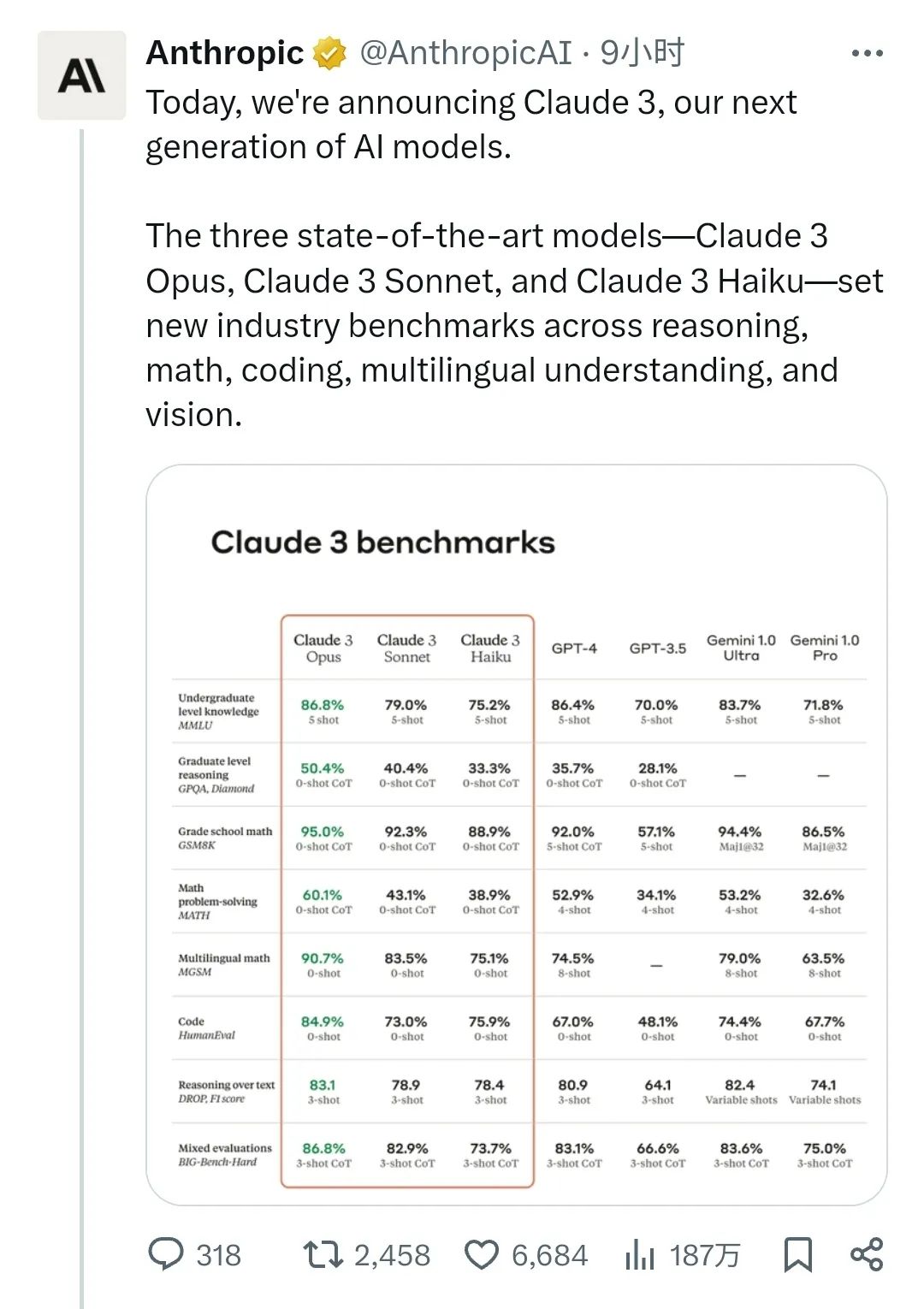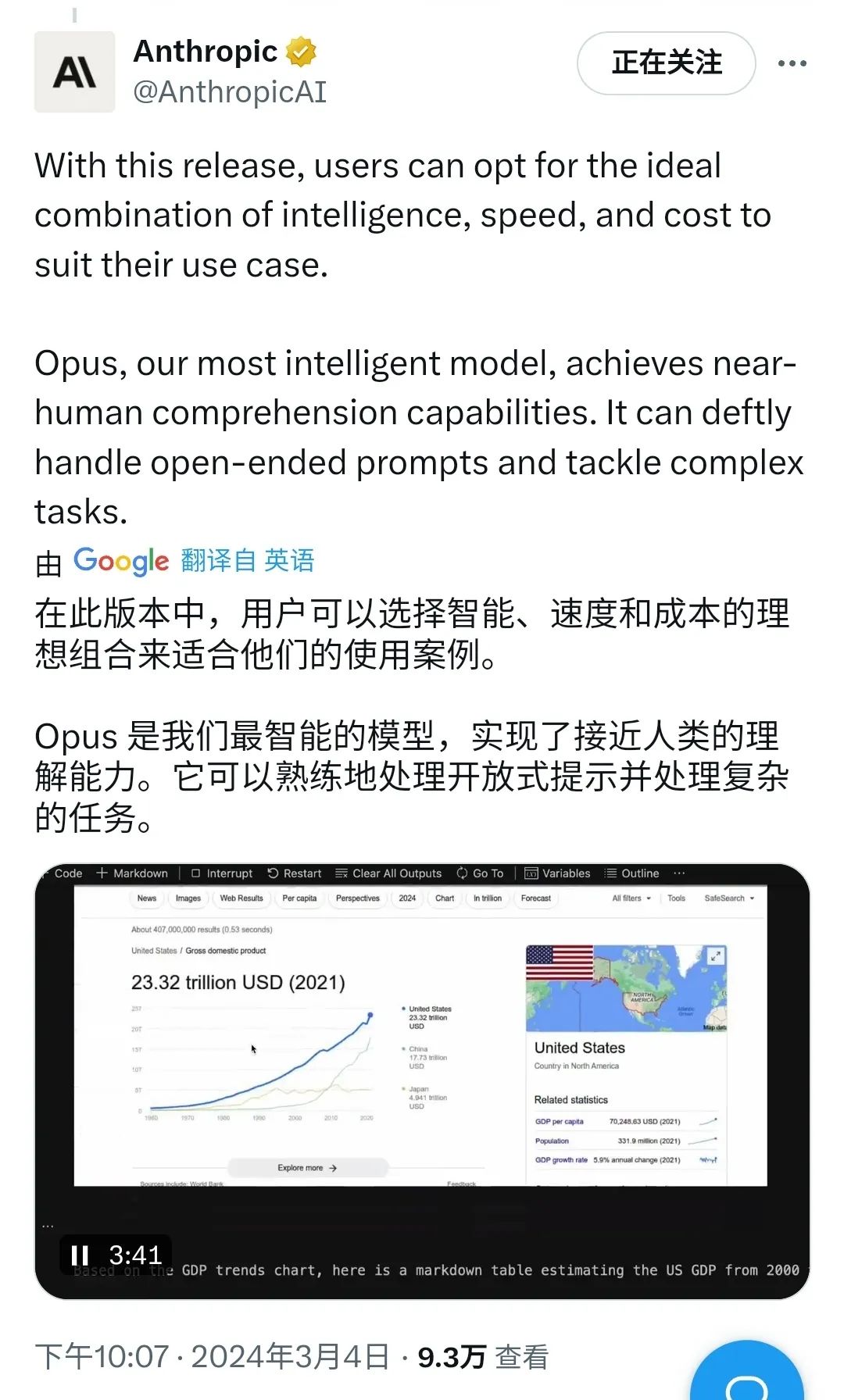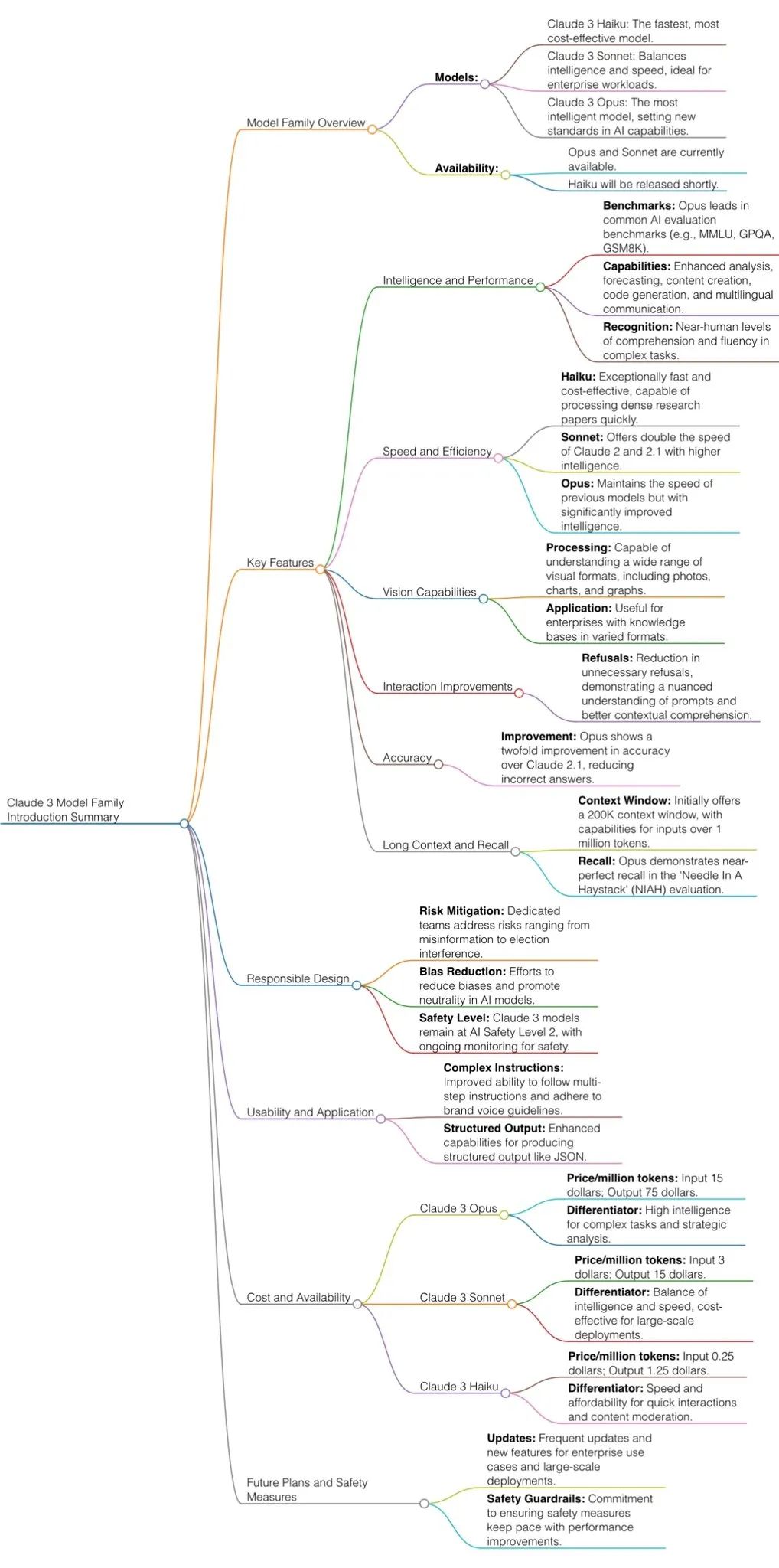 Technology peripherals
Technology peripherals
 AI
AI
 Claude3 taught GPT4 a lesson! Open AI's strongest opponent is a late-night bomb, with full picture analysis!
Claude3 taught GPT4 a lesson! Open AI's strongest opponent is a late-night bomb, with full picture analysis!
Claude3 taught GPT4 a lesson! Open AI's strongest opponent is a late-night bomb, with full picture analysis!
Produced by 51CTO Technology Stack (WeChat ID: blog51cto)
Late at night, OpenAI’s strongest rival Anthropic released three new SOTA products in one go, including: Claude 3 Haiku, Claude 3 Sonnet and Claude 3 Opus. The industry exclaimed: Claude 3 brings a series of new industry benchmarks.
Among them, Opus means an epic movement, Sonnet means a sonnet, and Haiku means a haiku, a three-line short poem.
It is reported (Figure 9) that Haiku is the fastest and most cost-effective model in the AI market. It can read informative and data-intensive research papers (~10k tokens) on arXiv containing charts and graphs in less than three seconds.
Figure 8, for the vast majority of workloads, Sonnet is 2 times faster than Claude 2 and Claude 2.1, and has a higher level of intelligence. It excels at tasks that require fast responses, such as knowledge retrieval or sales automation. Opus is similar in speed to Claude 2 and 2.1, but has a higher level of intelligence.
Opus is Anthropic’s smartest model currently, outperforming its peers on most common evaluation benchmarks for artificial intelligence systems, including Undergraduate Level Expert Knowledge (MMLU), Graduate Level Expert Reasoning (GPQA), and Basic Mathematics (GSM8K) etc. It demonstrates near-human-level understanding and fluency on complex tasks, leading the frontier of general intelligence.
The above three Claude 3 models all show greater capabilities in analysis and prediction, detailed content creation, code generation, and conversation in non-English languages such as Spanish, Japanese, and French.
In addition, the Claude 3 series has near-perfect memory capabilities and ultra-long text windows, which will provide 200K context windows. And it can accept the input of more than 1 million tokens, and will be gradually released according to customer needs.
Overall, Claude3 has three shocking features:
1. The benchmark of domain experts. Three expert fields of finance/medicine/philosophy were selected as test benchmarks. NVIDIA Research Manager Jim Fan said that "it is recommended that all LLMs follow this so that different downstream applications know what will happen."
2. Rejection rate analysis. LLM has become an epidemic with overly cautious answers to many "innocent questions". Claude has been committed to safe AI research and has made efforts in this area.
3. Complex visual features comparable to other leading models. Works with a variety of visual formats including photos, diagrams, graphics and technical diagrams, PDFs, flowcharts or presentation slides.
How is the actual evaluation?
A netizen asked GPT4 and Claude3 to write a login interface code respectively. The actual running test results (Figure 13) show that the latter is better in App interface design.











##



The above is the detailed content of Claude3 taught GPT4 a lesson! Open AI's strongest opponent is a late-night bomb, with full picture analysis!. For more information, please follow other related articles on the PHP Chinese website!

Hot AI Tools

Undresser.AI Undress
AI-powered app for creating realistic nude photos

AI Clothes Remover
Online AI tool for removing clothes from photos.

Undress AI Tool
Undress images for free

Clothoff.io
AI clothes remover

AI Hentai Generator
Generate AI Hentai for free.

Hot Article

Hot Tools

Notepad++7.3.1
Easy-to-use and free code editor

SublimeText3 Chinese version
Chinese version, very easy to use

Zend Studio 13.0.1
Powerful PHP integrated development environment

Dreamweaver CS6
Visual web development tools

SublimeText3 Mac version
God-level code editing software (SublimeText3)

Hot Topics
 Choosing the embedding model that best fits your data: A comparison test of OpenAI and open source multi-language embeddings
Feb 26, 2024 pm 06:10 PM
Choosing the embedding model that best fits your data: A comparison test of OpenAI and open source multi-language embeddings
Feb 26, 2024 pm 06:10 PM
OpenAI recently announced the launch of their latest generation embedding model embeddingv3, which they claim is the most performant embedding model with higher multi-language performance. This batch of models is divided into two types: the smaller text-embeddings-3-small and the more powerful and larger text-embeddings-3-large. Little information is disclosed about how these models are designed and trained, and the models are only accessible through paid APIs. So there have been many open source embedding models. But how do these open source models compare with the OpenAI closed source model? This article will empirically compare the performance of these new models with open source models. We plan to create a data
 A new programming paradigm, when Spring Boot meets OpenAI
Feb 01, 2024 pm 09:18 PM
A new programming paradigm, when Spring Boot meets OpenAI
Feb 01, 2024 pm 09:18 PM
In 2023, AI technology has become a hot topic and has a huge impact on various industries, especially in the programming field. People are increasingly aware of the importance of AI technology, and the Spring community is no exception. With the continuous advancement of GenAI (General Artificial Intelligence) technology, it has become crucial and urgent to simplify the creation of applications with AI functions. Against this background, "SpringAI" emerged, aiming to simplify the process of developing AI functional applications, making it simple and intuitive and avoiding unnecessary complexity. Through "SpringAI", developers can more easily build applications with AI functions, making them easier to use and operate.
 Can online maps still be like this? MapTracker: Use tracking to realize the new SOTA of online maps!
Apr 25, 2024 pm 05:01 PM
Can online maps still be like this? MapTracker: Use tracking to realize the new SOTA of online maps!
Apr 25, 2024 pm 05:01 PM
Written above & the author’s personal understanding is that this algorithm allows for online high-precision map construction. Our method, MapTracker, accumulates sensor streams into memory buffers for two displays: 1) Rasterlatents in Bird's Eye View (BEV) space and 2) Vectorlatents on road elements (i.e., crosswalks, lane lines, and road boundaries). The method draws on the query propagation paradigm in object tracking, which explicitly associates the tracked road elements of the previous frame with the current frame, while fusing a subset of memory latents with distance strides to open source link: https: //map-tracker.github.io/ In summary, the main contributions of this article are as follows: A new
 Rust-based Zed editor has been open sourced, with built-in support for OpenAI and GitHub Copilot
Feb 01, 2024 pm 02:51 PM
Rust-based Zed editor has been open sourced, with built-in support for OpenAI and GitHub Copilot
Feb 01, 2024 pm 02:51 PM
Author丨Compiled by TimAnderson丨Produced by Noah|51CTO Technology Stack (WeChat ID: blog51cto) The Zed editor project is still in the pre-release stage and has been open sourced under AGPL, GPL and Apache licenses. The editor features high performance and multiple AI-assisted options, but is currently only available on the Mac platform. Nathan Sobo explained in a post that in the Zed project's code base on GitHub, the editor part is licensed under the GPL, the server-side components are licensed under the AGPL, and the GPUI (GPU Accelerated User) The interface) part adopts the Apache2.0 license. GPUI is a product developed by the Zed team
 Posthumous work of the OpenAI Super Alignment Team: Two large models play a game, and the output becomes more understandable
Jul 19, 2024 am 01:29 AM
Posthumous work of the OpenAI Super Alignment Team: Two large models play a game, and the output becomes more understandable
Jul 19, 2024 am 01:29 AM
If the answer given by the AI model is incomprehensible at all, would you dare to use it? As machine learning systems are used in more important areas, it becomes increasingly important to demonstrate why we can trust their output, and when not to trust them. One possible way to gain trust in the output of a complex system is to require the system to produce an interpretation of its output that is readable to a human or another trusted system, that is, fully understandable to the point that any possible errors can be found. For example, to build trust in the judicial system, we require courts to provide clear and readable written opinions that explain and support their decisions. For large language models, we can also adopt a similar approach. However, when taking this approach, ensure that the language model generates
 Don't wait for OpenAI, wait for Open-Sora to be fully open source
Mar 18, 2024 pm 08:40 PM
Don't wait for OpenAI, wait for Open-Sora to be fully open source
Mar 18, 2024 pm 08:40 PM
Not long ago, OpenAISora quickly became popular with its amazing video generation effects. It stood out among the crowd of literary video models and became the focus of global attention. Following the launch of the Sora training inference reproduction process with a 46% cost reduction 2 weeks ago, the Colossal-AI team has fully open sourced the world's first Sora-like architecture video generation model "Open-Sora1.0", covering the entire training process, including data processing, all training details and model weights, and join hands with global AI enthusiasts to promote a new era of video creation. For a sneak peek, let’s take a look at a video of a bustling city generated by the “Open-Sora1.0” model released by the Colossal-AI team. Open-Sora1.0
 The local running performance of the Embedding service exceeds that of OpenAI Text-Embedding-Ada-002, which is so convenient!
Apr 15, 2024 am 09:01 AM
The local running performance of the Embedding service exceeds that of OpenAI Text-Embedding-Ada-002, which is so convenient!
Apr 15, 2024 am 09:01 AM
Ollama is a super practical tool that allows you to easily run open source models such as Llama2, Mistral, and Gemma locally. In this article, I will introduce how to use Ollama to vectorize text. If you have not installed Ollama locally, you can read this article. In this article we will use the nomic-embed-text[2] model. It is a text encoder that outperforms OpenAI text-embedding-ada-002 and text-embedding-3-small on short context and long context tasks. Start the nomic-embed-text service when you have successfully installed o
 Microsoft, OpenAI plan to invest $100 million in humanoid robots! Netizens are calling Musk
Feb 01, 2024 am 11:18 AM
Microsoft, OpenAI plan to invest $100 million in humanoid robots! Netizens are calling Musk
Feb 01, 2024 am 11:18 AM
Microsoft and OpenAI were revealed to be investing large sums of money into a humanoid robot startup at the beginning of the year. Among them, Microsoft plans to invest US$95 million, and OpenAI will invest US$5 million. According to Bloomberg, the company is expected to raise a total of US$500 million in this round, and its pre-money valuation may reach US$1.9 billion. What attracts them? Let’s take a look at this company’s robotics achievements first. This robot is all silver and black, and its appearance resembles the image of a robot in a Hollywood science fiction blockbuster: Now, he is putting a coffee capsule into the coffee machine: If it is not placed correctly, it will adjust itself without any human remote control: However, After a while, a cup of coffee can be taken away and enjoyed: Do you have any family members who have recognized it? Yes, this robot was created some time ago.





